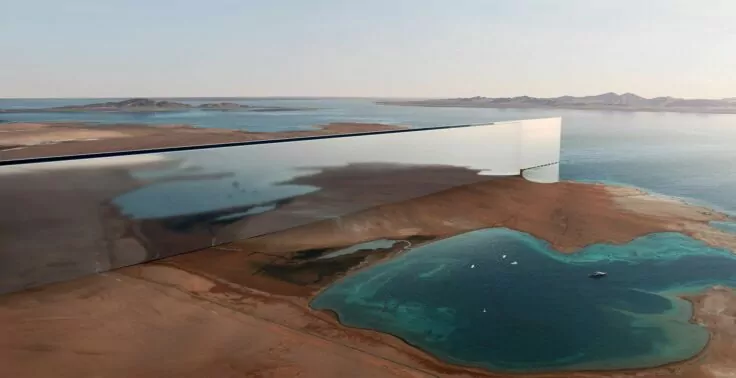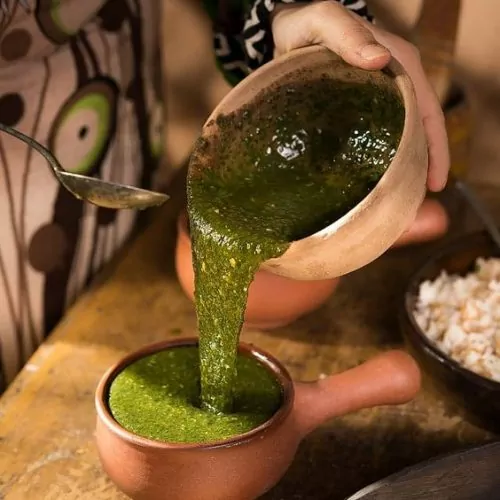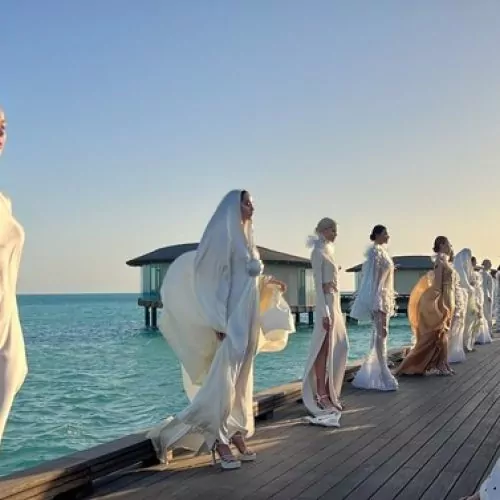In a world where headlines often focus on conflicts, crises, and environmental issues, it might be difficult to think about what lies ahead. This might be the reason why science fiction has become a valuable tool for exploring the uncertainties of tomorrow.
Glimpses of the future taking shape in the form of ambitious urban projects can already be seen in the Middle East. In fact, Saudi Arabia’s “The Line,” a cornerstone of the Vision 2030 initiative, and Egypt’s New Administrative Capital are said to revolutionize urban living.
In a time of uncertainty, these initiatives offer hope and inspiration, showcasing a future where imagination and practicality converge to address the challenges of tomorrow. Emphasizing sustainability and innovation, they envision a new way to conceive a city, particularly in Saudi Arabia’s case with Neom’s linear shape as well as its idea to be car-free, though there are many concerns regarding the potential environmental impact, human rights issues, lack of transparency, economic viability, and technological challenges.

This “futurama mania” extends its influence into the realms of art and literature, notably through the emergence of Arab Futurism. According to Teresa Pepe, professor and scholar at the University of Oslo specializing in Modern and contemporary Arabic literature, the movement is a broad cultural tendency within the Arabic sphere to contemplate, imagine, and depict future scenarios, primarily through visual arts.
Taking root around 2015, this movement sees the artistic community redefining notions of modernity by addressing themes such as ecology, gender, decolonialism, and globalization. Drawing inspiration from Western science fiction, they craft representations that reflect the evolving landscape of the South West Asia and North Africa (SWANA) region, offering their unique visions of the future while grounding them in local contexts.
Over the past few decades, the region has been marked by revolutions, shifting power, and religious dynamics. Concurrently, it has found itself on the frontline of climate change impacts, with temperatures hitting record highs in recent years. The construction of the Line appears to be a response to the anxieties stemming from the profound transformations underway in the region. Moreover, these megacities emerging from the region assert a certain presence and, dare I say, dominance in the urban landscape in opposition to the West.
Within this context, artists have assumed the role of societal observers, capturing through their art the palpable anxieties surrounding impending changes and uncertain futures. For Pepe, what is interesting is how this project combines different temporalities. “You have the future, you have the present, and then you have the past, right? And what they want to show us is that the future can be very much a replica of the past,” she said.
Arab Futurism has however developed on a base of scientifical and technical progress, where trends and aesthetics are used to question ideologies and the reality, we live in.
“To build my practice, I use all the information and knowledge I felt I had like what are one more subcultural forms of knowledge at the time, versus more institutional ways of representing the problems that were happening in that movement. The loss of lives, the loss of space and cities, and just generally queer struggle, and then I started merging it with how I felt Palestinian,” explains Gaby Sahhar in their art studio in East London of his work.

They show me one of their paintings, where in front of us, a dystopian urban landscape, with a stark contrast between a fortified wall and a distant cityscape lay. Sahhar, currently exhibiting in Paris and Berlin, elaborates on their artistic journey, influenced by a multicultural upbringing as a French-Palestinian raised in London. Recalling a pivotal reconnection with their roots in Bethlehem in 2016, Sahhar describes how their imagination, fueled by stories and experiences of Palestine, became a driving force in their work. “It was only in 2016 that I reconnected with brothers and sisters in Bethlehem. I feel like because my brain was deprived of an experience or a place, I had to use what my imagination has formed through trips to Palestine, through stories that I had been told or fed through my dad.”
Another painting captures the eye. It features figures in chrome armor, almost alien-shaped in appearance. Sahhar elaborates, “I wanted to portray strong, transcendent figures that surpass traditional notions of gender, using sci-fi and alien-like elements that connect with architecture as a medium for this expression.”
Their aim is to blend and juxtapose the landscapes of Europe and the Middle East—particularly Palestine, creating what they describe as “experimental environments.” Through their art, Sahhar endeavors to challenge and expand the conventional perceptions of Palestine, often depicted through a lens of conflict and devastation.

One standout piece showcases an urban scene featuring a train station, symbolically linking the UK to Palestine. Their work, according to Sahhar, represents an alternative vision of the future—one that moves beyond the prevalent imagery of violence to suggest new possibilities and connections.
In Arab Futurism, artists use their work to highlight social inequalities and explore deep moral questions. They often center their stories around new characters, using these narratives to reflect on and challenge the realities of their own regions. Pepe points out that in Arab Futurist literature, the future settings are often very much like the present day. This approach criticizes the common belief that the future will automatically be better than the present. “The future here is shown as a progress. So either it will be more negative, or it will be the same, because we are stuck. There is no transformation taking place.”
Arabic science fiction is deeply rooted in the political climates of the 20th and 21st centuries. The genre often imagines hypothetical societies that reflect real-world characteristics. Particularly popular and well-developed in Egypt, where it has found a receptive audience, Levantine authors have been creating new utopian societies that champion values such as equality, liberty, and justice. However, following the Arab Spring uprisings in 2011 and the subsequent political disillusionment, dystopian themes have come to dominate the genre. This shift reflects a growing skepticism about the potential for positive change after such turbulent events.
In 2013, Comma Press launched a series of anthologies titled “+100,” each set a century after a significant political event and focused on a different country, including Palestine, Kurdistan, Egypt, and Iraq.
In “Palestine +100,” edited by Basma Ghalayini and envisioning 2048—a century after the Nakba—the introduction posits that for Palestinian writers, the past is crucial as it forms the core of their identity. It suggests that envisioning a future is particularly challenging because “past is everything to a Palestinian writer.” This anthology allows for a reimagining and reformulation of the present, projecting a future that closely mirrors our current realities.
In the anthology, one notable contribution comes from Selma Dabbagh, a British Palestinian writer. Her story, Sleep it off, Dr. Schott, unfolds in a 2048 secular scientific enclave in Gaza, reflecting a future where a siege of the occupied enclave still exists, and residency in Israel is limited to individuals with more than 50% Jewish DNA. Dabbagh’s narrative explores how religious identity could shape the region’s future, depicting Palestinians engaged in building hyperloops and ethical block chain currencies. Her work underscores the urgency of adopting a more positive outlook in writing, given that reality often catches up with fiction rapidly.
Published in 2018, her story predated yet did not anticipate the intensifying Israeli actions in Gaza beginning on Oct. 7, highlighting the unknown and the limits of speculative fiction. She points out the difficulty of imagining the future during prolonged tumultuous periods, suggesting that, as nations evolve rapidly, art continues to serve as a crucial medium.
Arab Futurism does more than just critique the present– it imagines possible futures and warns us about paths we might want to avoid. By exploring issues related to territory and human experience, it helps make sense of our complex world and guides us toward navigating an uncertain future. This genre isn’t just for entertainment, but it enlightens us, offering insights that help us understand what changes might be coming and how we can prepare for them.
Main image: Still from Arabian Alien directed by Meshal Al Jaser




